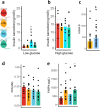The metabolic consequences of 'yo-yo' dieting are markedly influenced by genetic diversity
- PMID: 38961153
- PMCID: PMC11281900
- DOI: 10.1038/s41366-024-01542-2
The metabolic consequences of 'yo-yo' dieting are markedly influenced by genetic diversity
Abstract
Background: Weight loss can improve the metabolic complications of obesity. However, it is unclear whether insulin resistance persists despite weight loss and whether any protective benefits are preserved following weight regain (weight cycling). The impact of genetic background on weight cycling is undocumented. We aimed to investigate the effects of weight loss and weight cycling on metabolic outcomes and sought to clarify the role of genetics in this relationship.
Method: Both C57BL/6 J and genetically heterogeneous Diversity Outbred Australia (DOz) mice were alternately fed high fat Western-style diet (WD) and a chow diet at 8-week intervals. Metabolic measures including body composition, glucose tolerance, pancreatic beta cell activity, liver lipid levels and adipose tissue insulin sensitivity were determined.
Results: After diet switch from WD (8-week) to chow (8-week), C57BL/6 J mice displayed a rapid normalisation of body weight, adiposity, hyperinsulinemia, liver lipid levels and glucose uptake into adipose tissue comparable to chow-fed controls. In response to the same dietary intervention, genetically diverse DOz mice conversely maintained significantly higher fat mass and insulin levels compared to chow-fed controls and exhibited much more profound interindividual variability than C57BL/6 J mice. Weight cycled (WC) animals were re-exposed to WD (8-week) and compared to age-matched controls fed 8-week WD for the first time (LOb). In C57BL/6 J but not DOz mice, WC animals had significantly higher blood insulin levels than LOb controls. All WC animals exhibited significantly greater beta cell activity than LOb controls despite similar fat mass, glucose tolerance, liver lipid levels and insulin-stimulated glucose uptake in adipose tissue.
Conclusion: Following weight loss, metabolic outcomes return to baseline in C57BL/6 J mice with obesity. However, genetic diversity significantly impacts this response. A period of weight loss does not provide lasting benefits after weight regain, and weight cycling is detrimental and associated with hyperinsulinemia and elevated basal insulin secretion.
© 2024. The Author(s).
Conflict of interest statement
The authors declare no competing interests.
Figures





Similar articles
-
Weight cycling exacerbates glucose intolerance and hepatic triglyceride storage in mice with a history of chronic high fat diet exposure.J Transl Med. 2025 Jan 4;23(1):7. doi: 10.1186/s12967-024-06039-0. J Transl Med. 2025. PMID: 39754229 Free PMC article.
-
Metabolic dysfunction following weight cycling in male mice.Int J Obes (Lond). 2017 Mar;41(3):402-411. doi: 10.1038/ijo.2016.193. Epub 2016 Nov 14. Int J Obes (Lond). 2017. PMID: 27840414 Free PMC article.
-
db/db Mice Exhibit Features of Human Type 2 Diabetes That Are Not Present in Weight-Matched C57BL/6J Mice Fed a Western Diet.J Diabetes Res. 2017;2017:8503754. doi: 10.1155/2017/8503754. Epub 2017 Sep 6. J Diabetes Res. 2017. PMID: 29038790 Free PMC article.
-
Partial leptin deficiency confers resistance to diet-induced obesity in mice.Mol Metab. 2020 Jul;37:100995. doi: 10.1016/j.molmet.2020.100995. Epub 2020 Apr 11. Mol Metab. 2020. PMID: 32289482 Free PMC article.
-
NTP Research Report on Baseline Characteristics of Diversity Outbred (J:DO) Mice Relevant to Toxicology Studies: Research Report 6 [Internet].Durham (NC): National Toxicology Program; 2018 Jun. Durham (NC): National Toxicology Program; 2018 Jun. PMID: 30188648 Free Books & Documents. Review.
Cited by
-
A Case Series on the Efficacy of the Pharmacological Treatment of Lipedema: The Italian Experience with Exenatide.Clin Pract. 2025 Jul 7;15(7):128. doi: 10.3390/clinpract15070128. Clin Pract. 2025. PMID: 40710038 Free PMC article.
References
-
- Lean ME, Leslie WS, Barnes AC, Brosnahan N, Thom G, McCombie L, et al. Primary care-led weight management for remission of Type 2 diabetes (DiRECT): an open-label, cluster-randomised trial. Lancet. 2018;391:541–51. - PubMed
-
- Bangalore S, Fayyad R, Laskey R, DeMicco DA, Messerli FH, Waters DD. Body-weight fluctuations and outcomes in coronary disease. N. Engl J Med. 2017;376:1332–40. - PubMed
-
- Thaiss CA, Itav S, Rothschild D, Meijer MT, Levy M, Moresi C, et al. Persistent microbiome alterations modulate the rate of post-dieting weight regain. Nature. 2016;540:544–51. - PubMed
Publication types
MeSH terms
LinkOut - more resources
Full Text Sources
Medical

